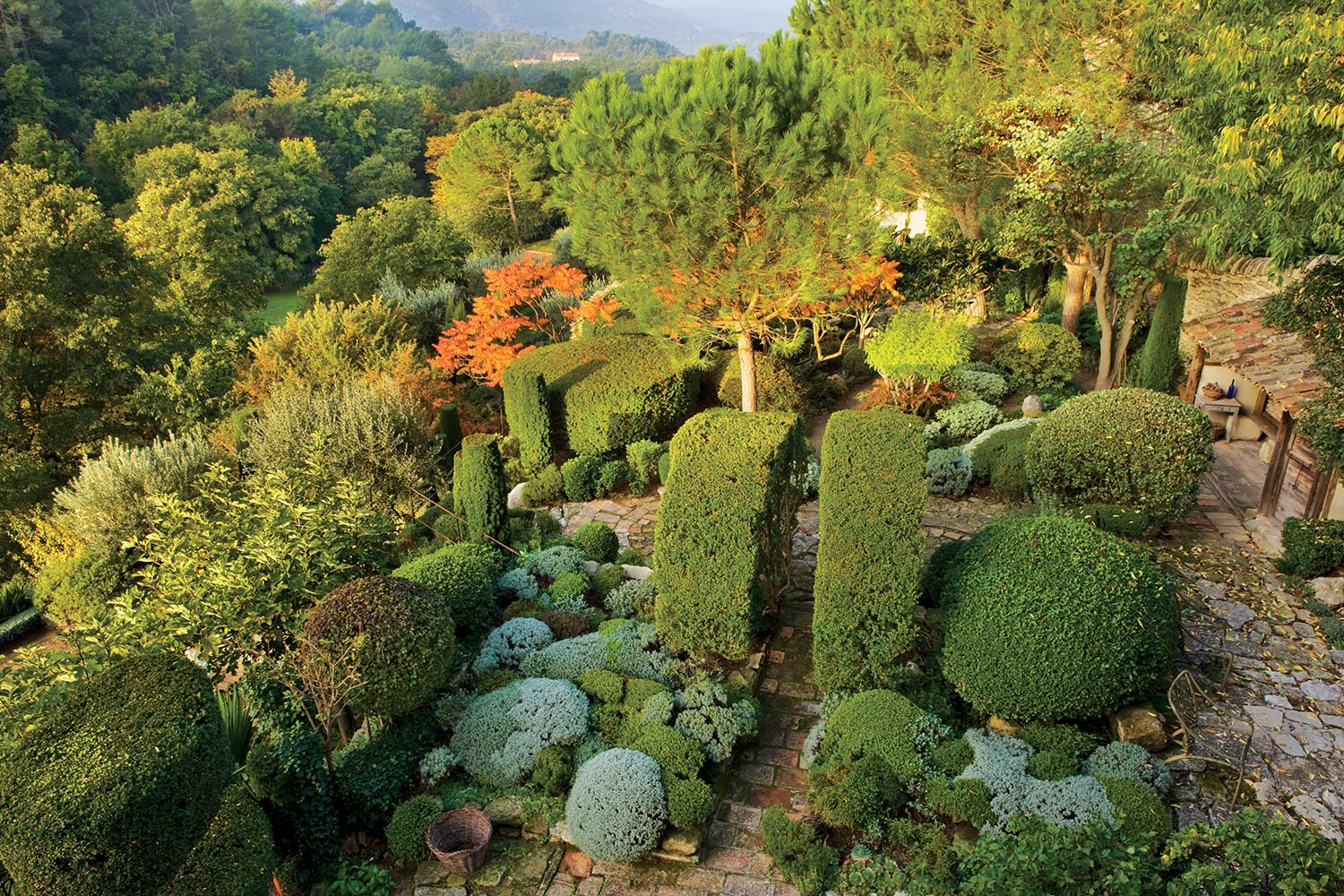Not everyone can move seamlessly from one successful career to another, especially when you are just shy of your 70th birthday—but Nicole de Vésian did just that. As a consultant and textile specialist in the early years, she worked in both New York and Paris. Later, in the 60s, she was a designer exclusively for Hermès, working alongside a young Christian Lacroix. Jean-Louis Dumas, then director, once described her as “the Hermès style incarnate.” But after 10 years of design in Paris, Nicole felt a calling to make a change and move to the Luberon region of Provence. It was there that she made her mark in gardening lore at her home called La Louve.
In 1986, Nicole settled in the village of Bonnieux and quickly gained a reputation for being both frugal and clever in the garden. Among her signature plants were the flat-topped cypress trees she acquired from nurseries when their tops had been burned by frost. She would continue to strike favorable financial deals with local nurserymen. As she once explained, “When you have nothing, you have to use your wits.”

Nicole, in her late 70s in the garden—tools always at hand. Photo by Pascal Chevallier

Art through horticulture: It’s not difficult to see why Judith Pillsbury, who bought the property from Nicole de Vésian, said, “La Louve is the most important work of art I own.” Photo by Clive Nichols
Any successful gardener knows it takes guts, experimentation, and a willingness to learn from your mistakes, and Nicole’s gardens at La Louve became her laboratoire of sorts. She learned to shake off the dirt and move forward, as well as how to look at things differently in order to begin again. To many, her style was that of a minimalist as she approached her gardens with an “almost biblical search for basics,” according to Christian Lacroix. He also states that Nicole had a “very civilized sense of the natural, which made her places as wild as they are rigorous with a je ne sais quoi all her own.”
Cypress, boxwood, bay laurel, rosemary, lavender, and thyme made up the color, texture, and fragrance palette of the grounds at La Louve. Occasionally, a random plant or flower would seed itself and be tolerated by Nicole. She was openminded with her garden and knew how to strike the balance between formal and wild—and that sometimes chance may improve upon a design. The hillside garden at La Louve was composed of three terraces and is best viewed from above. Many of the chosen plants were placed in groups to give the appearance of little tapestries of green, silver, and lavender. Nicole believed that “pruning is not control, but care.” As she once explained, her plants “only need a little shaping.”

A still life in stone: Basins, troughs, capitals, and orbs of stone all have purpose in their placement. Photo by Clive Nichols

Nicole once said, “My job is to give everyday things distinctive style.” Here, simple watering cans are placed for their visual appeal. Photo by Charlotte Moss
When it came to ornaments in the garden, she kept it relatively lean—a trough with a purpose, an obelisk for punctuation, a table for eating, a bench for rest and conversation. She unified most of these features using her favorite material, stone. I recently asked English garden designer Lady Tania Compton her thoughts about the La Louve landscape created by Nicole, whom she met in her days as garden editor for House & Garden magazine. She distilled it in these words: “Her garden was thoroughly Provençal whilst evoking the oriental tradition of garden making, where art imitates nature as a means of capturing its essence.”
On a visit to La Louve one summer, I remember standing on one of the stone terraces looking down and thinking how simple this limited palette appears yet knowing that the placement had been carefully calculated. Nicole was known for never drawing up plans—she saw her work as physical not philosophical. In fact, she often asked her gardeners to move pots, trees, and stones on the spot. They grew to accept her modus operandi that she executed with conviction and humor, and they respected her for it.

The characteristic garden style of Nicole de Vésian as seen here with multiple levels executed in varying heights, textures, and shapes in a broad palette of greens. Photo by Clive Nichols
When Nicole took on projects for clients, she always began by scrutinizing the site and then asking questions of the owners to better understand their desires and needs. She also liked to use an existing dominant feature on the site or something in its viewshed as a starting point. At the same time, she would consult her files of photos for inspiration. Architect and designer Victor Papanek summarized Nicole’s gardens best when he said they are “human in scale” and possess a “sensual frugality that results in true elegance.” A beautiful description and a high compliment indeed.
Occasionally, Nicole would place a bench backwards, allowing visitors the opportunity to review what they had just experienced. Some saw this as a metaphor for life—a reminder to stop and take another look. On reflection, I think not, as Nicole de Vésian was always looking to the future. Even at the age of 80, shortly before she passed away, Nicole remarked to a friend, “It is time to begin again.”
By Charlotte Moss

With a lifelong love of gardening, designer Charlotte Moss has long been intrigued with what draws people—especially women—into the world of horticulture. Some have made it their professions, while others have become enthusiasts, patrons, philanthropists, or simply weekend hobbyists. And then there are those who write about all things gardening. In her new column for FLOWER, Charlotte explores some of these women and the journeys that led to their passions for plants and flowers. She also has a forthcoming book with Rizzoli on the subject of gardening women set to release spring 2025.



